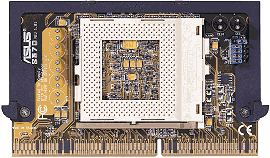Take Two: Dual Celeron in Action!
Take Two
If you take a look at the CPU market of the last months, you will realize that Intel has been releasing one Celeron version after the other. The Celeron at 466 MHz is the fastest version right now, most likely marking the end of the line for the Celerons at 66 MHz FSB. The next new Celeron at 500 MHz will be running at 100 MHz FSB, but this won't happen before Intel has released the successor of the BX-chipset, called 'Camino' and new Pentium III processors that run at 133 MHz FSB. Tom had the Celeron run at 618 MHz , which shows that this CPU is technically able to run at clock speeds way beyond 500 MHz. As you know, in many applications the Pentium II is a bit faster than a Celeron at same clock speed, due to the slower front side bus. Of course this is a disadvantage, but if you compare the price for a 466 MHz Celeron and a Pentium II 450 with memory and motherboard, you might understand what I mean.
Celeron Beats Pentium II
Except of the common benefits of a Celeron (low price, high performance) it comes with some other `goodies` on which you should take a look at. As you know, due to the multiplier lock of Celeron, overclocking is only possible by rising the bus speed. 66 MHz of course is not particularly standard any more, but as Intel wants to sell Pentium II CPUs as well, it will take some more time until we will get 100 MHz-Celerons. I suppose they will be available as soon as the Pentium III CPUs go 133 MHz.
As long as the Celeron is restricted to 66 MHz bus, the only thing you can do is either try to get one of the last 300 MHz Celerons, or run it at 75 or even 83 MHz bus speed. The 300 MHz type is the best one for overclocking, because you can simply change the FSB from 66 to 100 MHz and almost each of those CPUs runs at 450 MHz core speed. The 333 MHz model would have to bear 500 MHz, the 366 MHz type even 550 MHz, which won't run reliably without exotic cooling.
The 2nd best choice for overclocking are the Celeron models running at 366, 400 or 433 MHz. By rising the bus speed to 75 or 83 MHz you usually don't risk any components and still get higher CPU performance. So the Celeron 366 will run at 412 MHz, the 400 MHz type runs at 450 MHz and the Celeron 433 should reach 487 MHz. I intentionally wrote, should` because this is already a clock speed which the CPU possibly may not tolerate.
Slot-1 Or Socket 370?
There are some reasons why I prefer the Socket version of the Celeron: First, both the CPU and the motherboard are clearly cheaper than the slot versions. I also cannot support the argument that Socket 370 could be a one way path. One the one hand the Slot1 Celeron will soon go away, as already seen with Celeron 466, which is only available as PPGA-version. On the other one you can still use a PPGA-Celeron on a Slot-1 motherboard, all you need is an adapter card from one of the various motherboard makers. Those CPU converter boards have some other advantages, which you could find useful.
At the moment there are around 20 converter boards available, most from the known motherboard manufacturers. They all work fine basically, but some may have problems at 100 MHz bus speed. There is a few of them, which are better than the others:
Get Tom's Hardware's best news and in-depth reviews, straight to your inbox.
Rev. 1.02 - currently the smartest solution of a Socket 370 to Slot1-Converter
This card enables the PPGA-Celeron to run as dual-processor by default. It also enables you to adjust the CPU core-voltage between 1.8 - 2.6 V via 5 jumpers.

Patrick Schmid was the editor-in-chief for Tom's Hardware from 2005 to 2006. He wrote numerous articles on a wide range of hardware topics, including storage, CPUs, and system builds.
